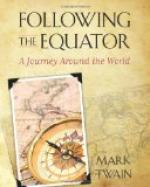When I had been marched two-thirds of the long distance and the misery of it was at the worst, the stately station-master stepped out from somewhere, and the soldier left me and darted after him and overtook him; and I could see by the soldier’s excited gestures that he was betraying to him the whole shabby business. The station-master was plainly very angry. He came striding down toward me, and when he was come near he began to pour out a stream of indignant Italian; then suddenly took off his hat and made that beautiful bow and said:
“Oh, it is you! I beg a thousands pardons! This idiot here—–” He turned to the exulting soldier and burst out with a flood of white-hot Italian lava, and the next moment he was bowing, and the soldier and I were moving in procession again—he in the lead and ashamed, this time, I with my chin up. And so we marched by the crowd of fascinated passengers, and I went forth to the train with the honors of war. Tobacco and all.
CHAPTER XXI.
Man will do many things to get himself loved, he will
do all things to get himself envied.
—Pudd’nhead
Wilson’s New Calendar.
Before I saw Australia I had never heard of the “weet-weet” at all. I met but few men who had seen it thrown—at least I met but few who mentioned having seen it thrown. Roughly described, it is a fat wooden cigar with its butt-end fastened to a flexible twig. The whole thing is only a couple of feet long, and weighs less than two ounces. This feather—so to call it—is not thrown through the air, but is flung with an underhanded throw and made to strike the ground a little way in front of the thrower; then it glances and makes a long skip; glances again, skips again, and again and again, like the flat stone which a boy sends skating over the water. The water is smooth, and the stone has a good chance; so a strong man may make it travel fifty or seventy-five yards; but the weet-weet has no such good chance, for it strikes sand, grass, and earth in its course. Yet an expert aboriginal has sent it a measured distance of two hundred and twenty yards. It would have gone even further but it encountered rank ferns and underwood on its passage and they damaged its speed. Two hundred and twenty yards; and so weightless a toy—a mouse on the end of a bit of wire, in effect; and not sailing through the accommodating air, but encountering grass and sand and stuff at every jump. It looks wholly impossible; but Mr. Brough Smyth saw the feat and did the measuring, and set down the facts in his book about aboriginal life, which he wrote by command of the Victorian Government.
What is the secret of the feat? No one explains. It cannot be physical strength, for that could not drive such a feather-weight any distance. It must be art. But no one explains what the art of it is; nor how it gets around that law of nature which says you shall not throw any two-ounce thing 220 yards, either through the air or bumping along the ground. Rev. J. G. Woods says:




